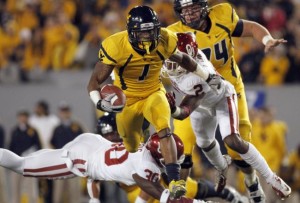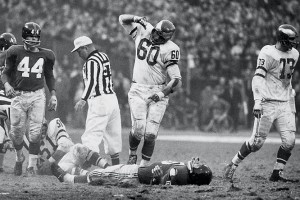I wrote about the Seattle Seahawks a number of weeks ago, specifically relating to the trade for Percy Harvin. I made the point that Seattle did not acquire Harvin solely to line him up at wide receiver. He will be so much more than that. He will align everywhere in the formation, the ultimate chess piece that can attack from anywhere on the board. Just like Cobb in Green Bay and Hernandez in New England. This is the light bulb moment. That’s exactly what Austin should be in the NFL. Those who see him solely as a slot receiver are stuck in conventional thinking, and missing the larger, more expansive point. Austin is not a static, inert player. He’s a movement player, a peripatetic ball of energy that creates all kinds of matchup issues for defenses.
I believe Austin, Hernandez, Cobb and Harvin are representative of where NFL teams would like to go with their personnel, and their passing concepts. The objective is to have five receivers, and certainly four, who can align all over the formation. Traditionally, they can be wide receivers, tight ends or running backs. It can be the Patriots with their “12” personnel. Or the Packers, with their four-wide receiver personnel. From a schematic perspective, it doesn’t matter how you define them by position. The overriding, and superseding point is that they are all movable chess pieces, all “Jokers”, to use the term that I’ve used before and I think is aptly descriptive. That’s the “Cosell Doctrine”, and that’s the direction I see the NFL game trending. It’s about passing, and how you can create, and ultimately dictate favorable matchups. You do that with players that are amorphous and fluid in their ability to be utilized in ways both multiple and expansive, yet somewhat unstructured based on conventional definitions.
Forgive me if I’ve missed the implication that this is how the NFL has always operated and that the NFL in 2013 is much more specialized that it has been for much of its history. Elroy Hirsch was a triple-threat halfback for Wisconsin when he rushed for 786 yards, passed for 226 yards, and added in 390 receiving yards for the Badgers in 1942. After World War II ended, Hirsch joined the All-America Football Conference as a running back and had three undistinguished years with the Chicago Rockets. He remained at the position when he joined the NFL’s Rams in 1949: at the time, Los Angeles had perhaps the league’s best receivers in Tom Fears and Bob Shaw. Hirsch struggled as a runner but was explosive enough to convince head coach Clark Shaughnessy to occasionally split him out wide before the snap. Crazy Legs impressed the Rams enough to trade Shaw after the season and move Hirsch permanently to end; Hirsch responded with one of the greatest seasons in NFL history with 1,495 receiving yards and 17 touchdowns in a twelve-game season in 1951.
Ray Renfro and Preston Carpenter both played halfback for the pre-Jim Brown Browns, but each had more success at other positions. Carpenter moved to receiver immediately after Cleveland drafted Brown and later made a Pro Bowl at tight end with the Steelers. Renfro struggled at running back but moved to flanker and made the Pro Bowl for Cleveland in 1960. A year after drafting Brown, Paul Brown drafted Illinois’ Bobby Mitchell to complement the powerfull fullback. Mitchell was an explosive halfback, punt returner, and kick returner for four years, but the Browns traded him to Washington in the Ernie Davis trade. Mitchell immediately moved to receiver with the Redskins and led the NFL with 1,384 receiving yards in 1962 and 1,436 receiving yards in 1963. In 1964, the Redskins drafted Charley Taylor, who was a mediocre running back for two-and-a-half years with the Skins before he turned into a Hall of Fame wide receiver for Washington.
As good as Mitchell and Taylor were, perhaps no player epitomizes the idea of a “space player” quite like the Colts Lenny Moore, who led the league in yards per rush in ’56, ’57, ’58, and ’61. He alternated between halfback and flanker for Baltimore, and teamed with Johnny Unitas to give opposing defenses nightmares. I wrote more about Gifford, Mitchell, Taylor, and Moore here at the old PFR Blog. Moore remains one of just four players in the 5,000/5,000 club, with Marcus Allen, Marshall Faulk, and Tiki Barber.
Positional-flexibility was very common in the 1960s, too. Johnny Morris won the NFL receiving triple crown with 93 catches, 1,200 yards, and 10 touchdowns in 1964, but he was a Pro Bowl returner and solid running back for the Bears early in his career. Bobby Joe Conrad was a jack-of-all-trades under Bear Bryant at Texas A&M and played running back and safety early in his NFL career; he then switched to wide receiver and led the NFL in receptions in 1963. The Giants Joe Morrison siwtched back and forth between running back and flanker during the decade depending on the team’s needs; he remained the Giants all-time leader in receptions until 2003. Alex Hawkins was the Colts backup swiss-army knife behind Moore, carrying 203 times in his first four years before switching to receiver full-time. SMU’s Frank Jackson was a halfback when Lamar Hunt’s team was in Dallas and a receiver when they moved to Kansas City. Bo Roberson couldn’t make it as a running back with the Chargers, but he had a couple of big years with the Raiders as a receiver. Warren McVea disappointed as a receiver with the Bengals but hung on as a running back with Kansas City and led the Super Bowl Champion Chiefs in rushing touchdowns in 1969.
The 1970s earned its reputation for having stuffed offensive innovation into a burlap sack, but Lionel James, Ronnie Harmon, and Eric Metcalf brought the “get this guy the ball” slash player back in style, and all spent time as runners, receivers, and returners. The Steelers used Antwaan Randle El (who twice had 100 rushing yards, 300 receiving yards, and 250 punt return yards in a season, not to mention a few completions, too) and Kordell Stewart in slash roles, and setting the stage for players like Josh Cribbs and Brad Smith. The year before Percy Harvin was drafted by the Vikings, the Jets brought undrafted rookie free agent RB/WR/Underdog Danny Woodhead on board. The year after Harvin, the Chiefs spent a second round pick on Dexter McCluster, who has 144 carries and 119 receptions in three years.
Versatility has always been important in the NFL, but as roster size increased the game became more specialized. Perhaps a player like Tavon Austin would have struggled in the ’70s or been treated like a round peg by a coach seeking a square hole in 1999, but for most of professional football history these multidimensional players have been in high demand. Austin makes his living as a “space” player, just like Harvin, Sproles, and Cobb. But Austin isn’t the first peripatetic ball of energy to enter the NFL.
The Oilers selected 5’9, 177-pound Jerry LeVias in the 1969 drat; LeVias became a Pro Bowl returner but enjoyed only moderate success as a receiver. Five years later Houston drafted Billy Johnson, who became one of the most famous return men in NFL history. Unfortunately, “White Shoes” never caught on in the Oilers offense, as he gained just 2,149 receiving yards (and 208 rushing yards) in seven seasons in Houston. Rick Upchurch (5’10, 175) was an immediate success in Denver as a returner, but it wasn’t until his fifth year that he became a capable offensive weapon. Players mentioned earlier like Lionel James (5’6, 171) and Eric Metcalf (5’10, 188) bounced between running back and receiver, but were often most valuable for what they did in the return games. Meanwhile, the late ’90s brought a bunch of water bug players who were outstanding returners and disappointing wide receivers.
Jermaine Lewis was 5’7, 183 pounds, and he helped the Ravens win a Super Bowl with his elite return skills. As a wide receiver, though, he was overmatched. Tim Dwight (5’8, 180) returned a kickoff for a touchdown in the Super Bowl and had some success as a deep threat, but could never turn into a starting caliber wide receiver. Az-Zahir Hakim was the icing on the cake for the Greatest Show on Turf, allowing the Rams to score before the offense even took the field. But the 5’10, 189-pound receiver disappointed on offense in both St. Louis and Detroit. Dante Hall (5’8, 187) was known as the X-Factor, but no matter how many times the Chiefs tried to put the ball in his hands on offense, it never seemed to work. You can say the same about Devin Hester, and early reports from the new regime in Chicago indicates that his time as an offensive player may be over.
It should go without saying that the failure of those players to succeed on offense has no relevance for how Austin’s career will unfold. Troy Brown, Santana Moss, Steve Smith, and Wes Welker also fall into the short, agile, punt-returner/slot receiver/space player that were also very good to excellent wide receivers. But that’s the point. Whether you look at Austin as a running back/wide receiver hybrid or a player with world-class agility that teams will try to get out in space, NFL teams have been trying to find Tavon Austins for as long as the NFL has been around.


